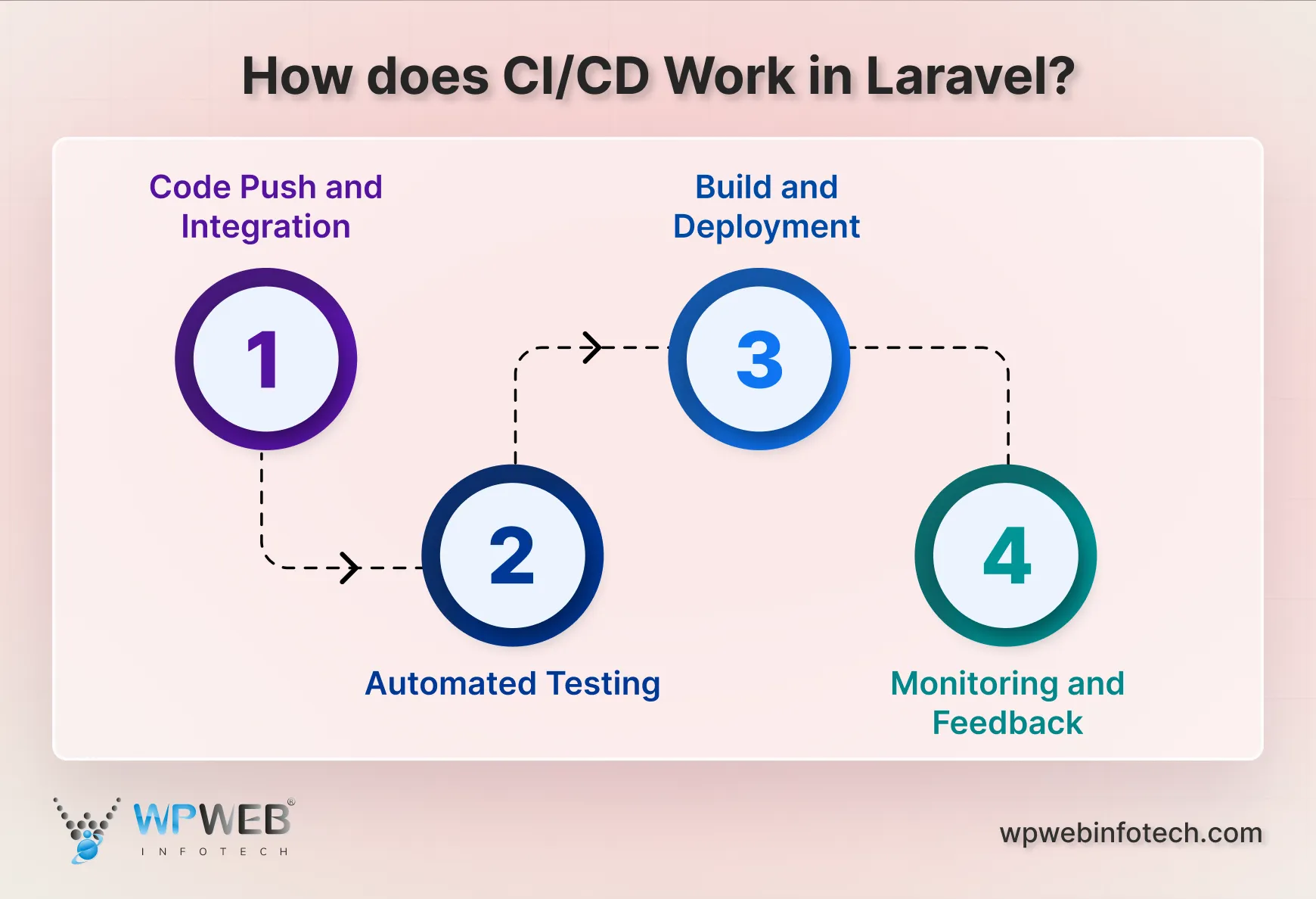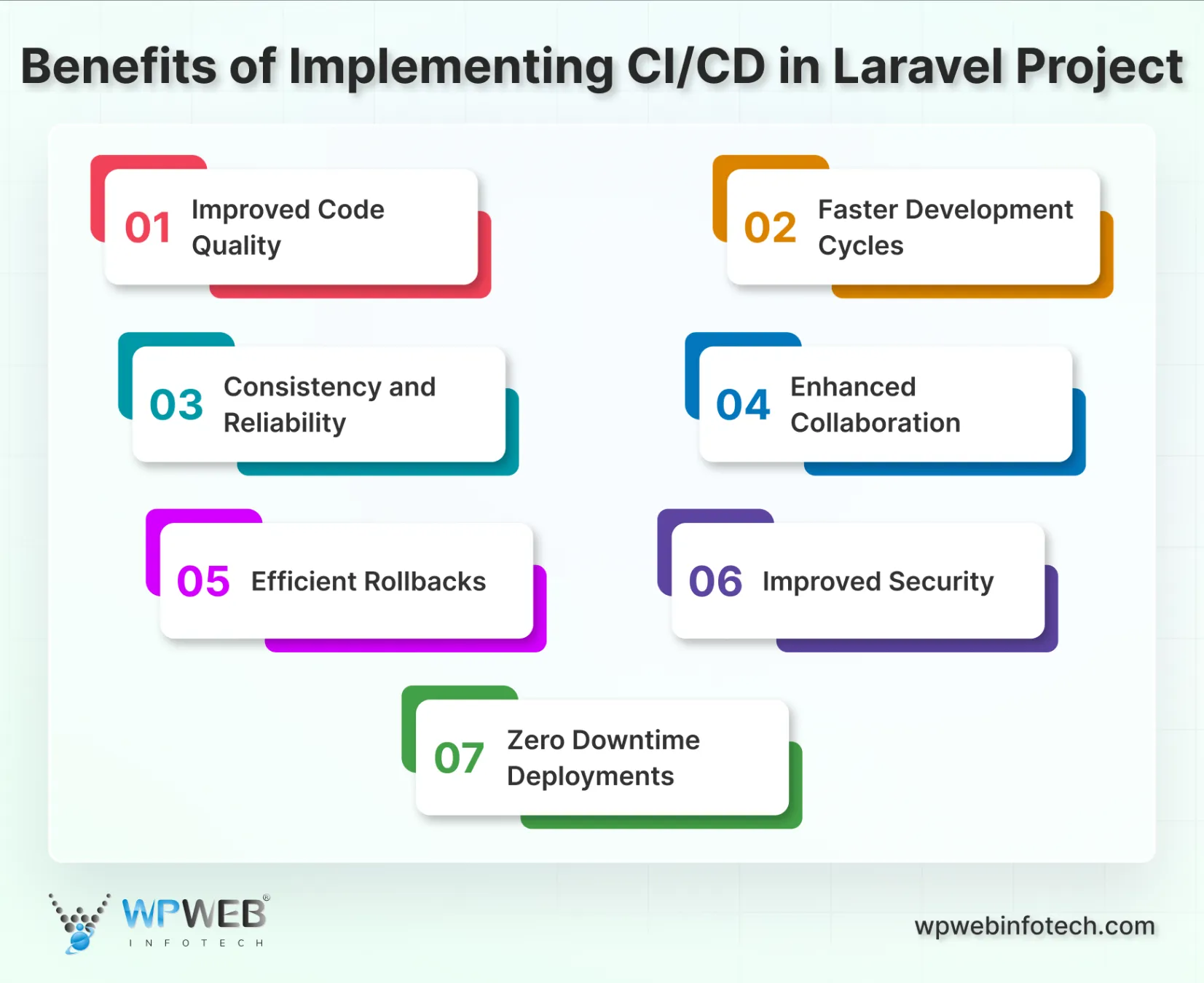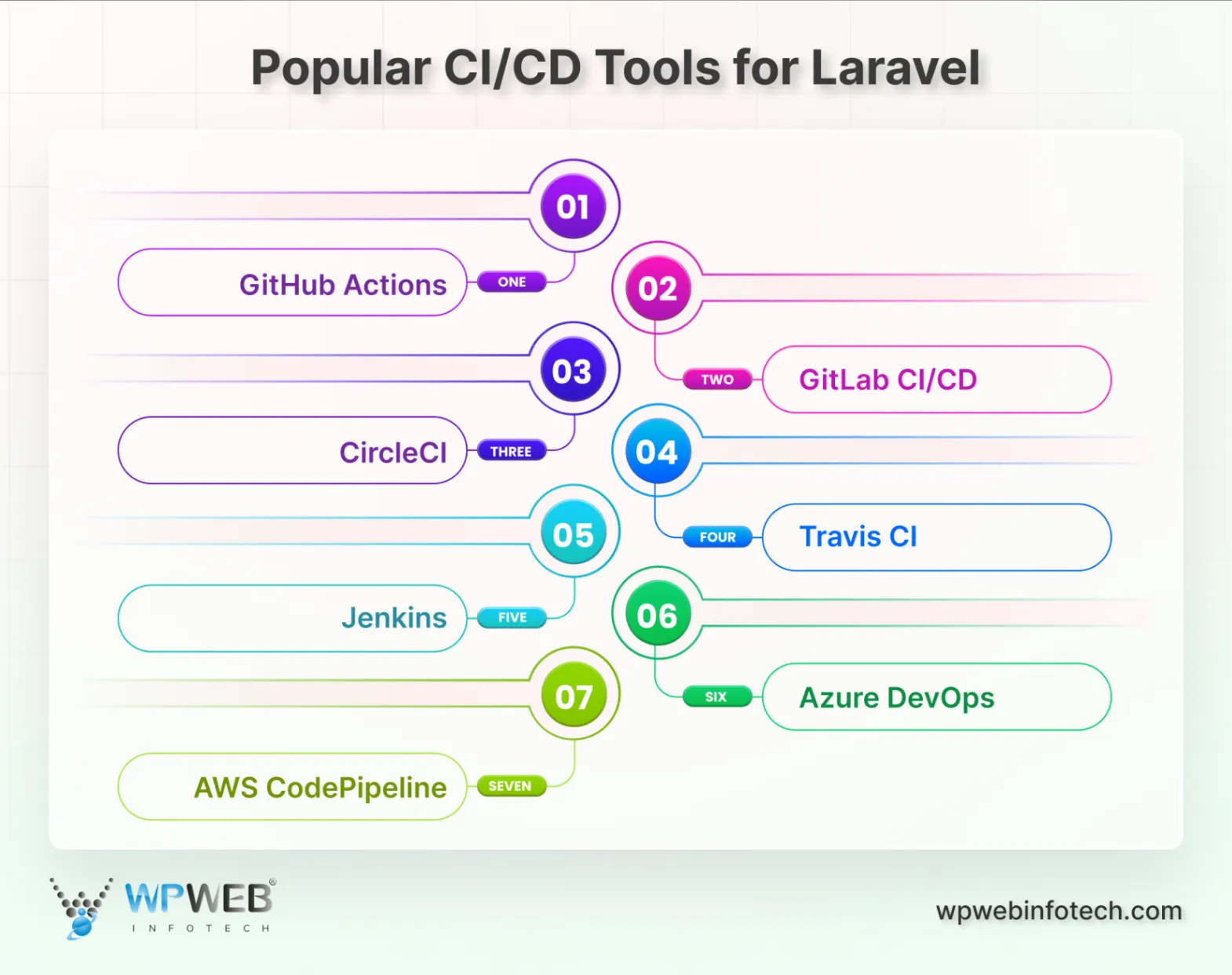Table of Contents
Ever struggled with the integration and deployment of your codebase in the live server? If yes, all you need to do is apply the CI/CD approach to your Laravel development. It will automate testing and deployment, ensuring smooth code integration and fast updates. Plus, it also minimizes bugs and reduces downtime, keeping your website available with almost zero downtime.
To help you with the same, we’ll guide you from the basic understanding of CI/CD to exploring popular CI/CD tools for Laravel. We’ll also help you learn how set up CI/CD in their projects. So, with that, let’s begin!
What is CI/CD in Laravel?
CI/CD in Laravel refers to the integration of Continuous Integration (CI) and Continuous Deployment (CD) practices within a Laravel project. This setup allows developers to automate the process of building, testing, and deploying their Laravel websites.
By using CI/CD, the development workflow becomes faster, more efficient, and more reliable. Plus, CI/CD pipelines ensure that code changes are continuously integrated, tested, and deployed with minimal manual intervention. With that, now let’s jump to how to set up CI/CD pipelines in the next section.
How does CI/CD Work in Laravel?
CI/CD in Laravel involves a series of automated processes that facilitate code integration, testing, and deployment. This workflow streamlines the development cycle, ensuring that code changes are rapidly and reliably deployed to production.

Code Push and Integration
- Developers push their code changes to a shared repository (GitHub, GitLab, Bitbucket).
- A CI tool (like GitHub Actions or GitLab CI/CD) automatically triggers a pipeline to start testing and building the Laravel project.
Automated Testing
- The CI tool runs PHPUnit tests, which verify that all Laravel features and functionalities work as expected.
- Code analysis tools (such as PHPStan or PHP CodeSniffer) are used to ensure that the code follows best practices and meets style guidelines.
- If any test fails, the CI pipeline stops, and developers receive immediate feedback about what went wrong.
Build and Deployment
- Once all tests pass, the CD part of the pipeline triggers.
- The application is automatically deployed to a staging or production environment. Tools like Laravel Forge or cloud-based services (AWS, DigitalOcean, etc.) can be used for deployment.
- Additional deployment tasks such as Laravel migrations, cache clearing, and configuration adjustments are automatically executed.
Monitoring and Feedback
- After deployment, monitoring systems track the performance and health of the Laravel application. If there are any issues, alerts are sent to the development team.
- If an error occurs in production, an automated rollback can be configured to restore the previous stable version.
CI/CD in Laravel automates integration and deployment processes, resulting in faster and more efficient development cycles. Understanding how to install and configure Laravel with Nginx on Ubuntu ensures a smooth server setup, optimized performance, and reliable application deployment.
How to Set Up CI/CD in Laravel Using GitHub Actions?
Setting up CI/CD in a Laravel project involves configuring various tools and services to automate the processes of building, testing, and deploying your application. Here’s a stepwise process to help you establish a CI/CD pipeline for your Laravel application:
Step 1: Choose Your CI/CD Tool
First, select a CI/CD tool that fits your project needs. Popular options include GitHub Actions, GitLab CI/CD, CircleCI, Travis CI, and Jenkins. For this guide, we’ll use GitHub Actions as an example.
Step 2: Prepare Your Laravel Project
Make sure your Laravel project is version-controlled with Git. If it’s not already a Git repository, initialize it using the command:
git init
Once initialized, create a repository on GitHub and push your Laravel project to it. Here are the commands:
git add .
git commit -m "Initial commit"
git remote add origin <your-repository-url>
git push -u origin main
Step 3: Create a GitHub Actions Workflow
In your Laravel project, create a directory for GitHub Actions workflows. This should be named .github/workflows. Here is the command:
mkdir -p .github/workflows
Next, create a YAML file (e.g., ci.yml) inside the .github/workflows directory, that defines your CI/CD workflow.
touch .github/workflows/ci.yml
Step 4: Define the CI/CD Pipeline
Edit the ci.yml file to specify the steps for your CI/CD pipeline. Below is a sample configuration for a Laravel application:
name: Laravel CI/CD
on:
push:
branches:
- main # Trigger the workflow on pushes to the main branch
pull_request:
jobs:
build:
runs-on: ubuntu-latest
steps:
- name: Checkout code
uses: actions/checkout@v2
- name: Set up PHP
uses: wpweb/setup-php@v2
with:
php-version: '8.0' # Specify your PHP version
extensions: mbstring, xml, ctype, json, bcmath, curl, fileinfo
- name: Install Composer dependencies
run: composer install --prefer-dist --no-progress --no-suggest --optimize-autoloader
- name: Run Tests
run: php artisan test
- name: Deploy to Server
run: |
ssh user@your-server "cd /path/to/your/app && git pull origin main && composer install --no-interaction --prefer-dist --optimize-autoloader"
env:
SSH_PRIVATE_KEY: ${{ secrets.SSH_PRIVATE_KEY }} # Add your SSH key to secrets
Step 5: Configure Deployment
Generate an SSH key pair for accessing your server. If you haven’t done this already, you can create a new key with the following command:
ssh-keygen -t rsa -b 4096 -C "your_email@example.com"
Now to add SSH private key to GitHub secrets, navigate to Settings > Secrets and Variables > Actions. Then, click on “New repository secret” and add a secret named SSH_PRIVATE_KEY. Paste the contents of your private key file (id_rsa) here.
For example, you might add secrets like:
- DB_CONNECTION
- DB_HOST
- DB_PORT
- DB_DATABASE
- DB_USERNAME
- DB_PASSWORD
Also, ensuring proper server configuration can help prevent common deployment issues such as laravel Nginx 502 bad gateway.
Step 6: Set Up Deployment
To include deployment in your CI/CD pipeline, add the necessary deployment steps within your workflow file. For scalable and managed cloud hosting, configure your application to deploy Laravel AWS Elastic Beanstalk, ensuring efficient performance and automated infrastructure management.
For example, you can deploy to a server using SSH or use services like Laravel Forge.
- name: Deploy to Server
run: |
ssh -o StrictHostKeyChecking=no user@your-server.com "cd /path/to/your/laravel/project && git pull origin main && composer install --no-dev && php artisan migrate --force"
env:
SSH_PRIVATE_KEY: ${{ secrets.SSH_PRIVATE_KEY }}
Step 7: Commit and Push Changes
Commit the .github/workflows/ci.yml file and push it to your GitHub repository.
git add .github/workflows/ci.yml
git commit -m "Set up CI/CD with GitHub Actions"
git push origin main
Step 8: Monitor and Optimize
The CI/CD pipeline automatically runs whenever changes are pushed to the main branch or a pull request is created. You can monitor the workflow status from the ‘Actions’ tab in your GitHub repository. Understanding how to deploy Laravel app ensures a smooth and automated deployment process for consistent application delivery.
You can view logs for each step, which helps diagnose any issues that arise. Consider adding more jobs, such as linting or security checks, to further enhance code quality.
Setting up CI/CD in Laravel using GitHub Actions automates the testing and deployment processes. That leads to more reliable and efficient development cycles. To build a website efficiently and effectively, hire Laravel developers. They will follow the best practices and approach during the development, ensuring your site performs optimally.
Benefits of Implementing CI/CD in Laravel Project

- Improved Code Quality: Implementing CI/CD in a Laravel project ensures that every code change is automatically tested. For advanced serverless deployment options, check out Laravel Vapor, which works seamlessly with CI/CD workflows. This practice helps in maintaining high code quality by catching bugs and errors early in the development cycle. Automated tests provide immediate feedback, allowing developers to fix issues promptly.
- Faster Development Cycles: CI/CD allows for rapid iteration, enabling developers to integrate code changes frequently. This leads to faster feedback and shorter development timelines, speeding up the delivery of new features and bug fixes.
- Consistency and Reliability: With CI/CD, you can ensure that code runs in standardized environments, reducing errors that can arise from different setups. This consistency reduces the chances of issues, leading to a more reliable application.
- Enhanced Collaboration: The CI/CD process fosters collaboration among team members by providing a unified place for integrating and deploying code changes. This shared process encourages communication and transparency. That makes it easier for teams to work together effectively.
- Efficient Rollbacks: In case of a failure in the production environment, CI/CD pipelines often include automated rollback mechanisms to revert to the previous stable version. This ensures that the website remains functional and minimizes downtime.
- Improved Security: Automated security tests and code scanning tools can be integrated into the CI/CD pipeline to catch security vulnerabilities early. That helps developers ensure the Laravel site’s security before it is deployed to production.
- Zero Downtime Deployments: Laravel deployment tools like Envoyer offer zero-downtime deployments. That means that even when new changes are deployed, the users don’t experience any interruption in service. That leads to a smoother user experience.
Popular CI/CD Tools for Laravel
When implementing CI/CD for Laravel projects, various tools can help streamline the process and improve efficiency. Here are some popular CI/CD tools commonly used for Laravel development:

GitHub Actions
GitHub Actions provides a powerful automation platform integrated directly into GitHub repositories. It allows developers to define workflows for CI/CD processes, including building, testing, and deploying Laravel applications. With a range of pre-built actions available, setting up pipelines is simple and customizable.
GitLab CI/CD
GitLab CI/CD is an integrated feature of GitLab that offers robust CI/CD capabilities. It allows developers to define their build, test, and deployment processes within the .gitlab-ci.yml file. GitLab CI/CD is particularly useful for Laravel projects hosted on GitLab repositories as it makes pipeline management a seamless experience.
CircleCI
CircleCI is a cloud-based CI/CD tool known for its speed and flexibility. It integrates easily with GitHub and Bitbucket repositories, allowing for quick setup. CircleCI supports parallel testing, which speeds up the testing process and provides insights into the CI/CD pipeline with detailed reports.
Travis CI
Travis CI is a continuous integration service that is widely used in the open-source community. It integrates seamlessly with GitHub repositories and provides simple configuration through a .travis.yml file. For Laravel projects, Travis CI can run automated tests and deploy applications to various platforms.
Jenkins
Jenkins is an open-source automation server that offers a highly customizable CI/CD pipeline for Laravel and other applications. With its vast plugin ecosystem, Jenkins can integrate with various tools and services, making it a versatile choice. While it requires more setup and maintenance than other options, it is powerful for teams looking for deep customization.
Azure DevOps
Azure DevOps provides a comprehensive suite of tools for managing the entire software development lifecycle, including CI/CD capabilities. With Azure Pipelines, teams can build, test, and deploy Laravel applications using various languages and platforms. Azure DevOps integrates well with Azure services, making it an excellent choice for projects hosted on Microsoft’s cloud.
AWS CodePipeline
AWS CodePipeline is a fully managed continuous delivery service that automates the release process for applications deployed on AWS. For Laravel projects hosted on AWS, it can integrate with other AWS services like CodeBuild and CodeDeploy to create a complete CI/CD pipeline. That enables seamless website updates and deployments.
Each of these tools offers unique features and integrations that can streamline the deployment process. Selecting the right CI/CD tool for your Laravel project depends on your requirements, preferences, and infrastructure.
Wrapping Up
Implementing CI/CD in Laravel can significantly streamline your development process. With CI, every code change is automatically tested to ensure stability. On the other hand, CD will ensure new features and fixes are deployed smoothly without manual effort.
Additionally, using the CI/CD approach also enhances productivity by catching issues early and reducing website downtime. To begin with the setup, you first need to choose a platform from options like GitHub Actions, Jenkins, and more. After that, you can define the workflow and configure and implement the deployment of your site.
If you are looking to build a website for which the codebase gets managed and deployed continuously, consult with expert Laravel development services.
FAQs About Setting Up CI/CD in Laravel
What tests should I include in my Laravel CI/CD pipeline?
Run automated tests using Laravel’s built-in testing tools, such as PHPUnit. Cover essential functionality, including unit tests, and database migration checks. Testing in CI/CD helps detect issues early in the development cycle.
How do I automate deployments in a Laravel CI/CD pipeline?
Use deployment commands in your CI/CD configuration file to update your server. For example, a GitHub Action can SSH into the server, pull the latest code, install dependencies, and run php artisan migrate. This reduces manual deployment steps and ensures consistency.
Can I deploy Laravel to different environments using CI/CD?
Yes. You can configure your CI/CD pipeline to deploy to various environments like development, staging, and production. Each environment can have its own deployment steps and triggers, ensuring that you can test your website completely before pushing it live.
Build Powerful Laravel Applications
Learn how to leverage Laravel's powerful features for efficient and scalable web development.





